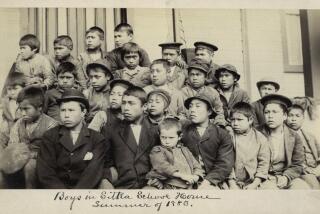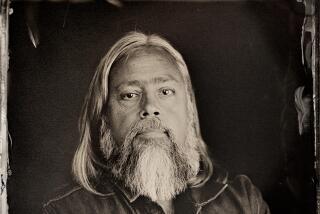This Time, It’s Native Americans Who Stake a Claim to Prime Land
WASHINGTON — The native tribes who inhabited the Americas when Christopher Columbus arrived more than 500 years ago reclaimed a piece of the nation’s capital as their own Tuesday.
As ceremonial drums beat, sage leaves burned and bells clanked from suede boots, 25,000 Indians from North, Central and South America marched in a procession from the oldest building on the National Mall, the Smithsonian Institution’s Castle, to dedicate the newest.
At 1:35 p.m., W. Richard West Jr., a Southern Cheyenne and Stanford University Law School graduate who wore a majestic feather headdress, walked across the threshold to officially open the National Museum of the American Indian that he has directed since it was founded in 1990.
The museum, the 18th facility under the Smithsonian’s cultural umbrella, offers a measure of reconciliation, giving the first inhabitants of the land the last planned symbolic spot on the Mall. A sense of justice reclaimed was a prevalent theme of the day’s opening ceremonies, attended by 80,000.
“To those within sight and sound of this occasion who descend from those who came, ‘Welcome to Native America,’ ” West said, noting that he had given years of thought to the dedication of the museum. “And I say to those who descend from native ancestors who were here, ‘Welcome home.’ ”
The $219-million museum, with its undulating limestone exterior meant to resemble the permanence of a building weathered by years of history, promises to be a significant addition to the Mall -- blending the legacy of grievance over land lost, treaties abrogated and Native Americans killed with the vibrancy of a current population enjoying an economic renaissance.
In recent years Native Americans have seen a financial resurgence -- not only from casino gambling profits, but from new businesses. Although the government sector remains the largest employer within Native American communities, small businesses have seen nearly 100% growth, generating much of the new job gains, according to a recent study by the Harvard Project on American Indian Economic Development.
Despite the day’s celebratory tone, museum critics are concerned that the exhibit whitewashes the violent clashes between European settlers and indigenous tribes and plays down the deaths of millions of Indians from disease and war. One group called on Congress to rename the site the National Holocaust Museum of the American Indian.
But history was not lost on the event’s speakers, including President Alejandro Toledo, Peru’s first popularly elected indigenous leader.
Sen. Ben Nighthorse Campbell (R-Colo.), the only Native American in the Senate, said the mass slaughter of Indians made them “America’s first endangered species.”
Sen. Daniel K. Inouye (D-Hawaii) said the enormity of the deaths came home to him when he first saw the remains of Indian bones and scalps while visiting the George Gustav Heye Center, the museum’s facility in New York.
“I asked myself, how would Irish Americans, German Americans or Japanese Americans react to having their ancestors’ remains housed in green boxes in a museum?” said Inouye, a Japanese American who fought for the United States in World War II, losing an arm from combat injuries.
West said the museum did not skirt its history, but also sought to reconcile the Native American place in modern American society.
“Today, Native America takes its rightful place in the National Mall in the very shadow of the Capitol itself,” he said.
For most Native Americans who gathered on the Mall, the day was a festival of culture and redemption. For all the attention to traditional dress, many wore T-shirts and jeans. Some sported American and Canadian flags. Dozens of veterans -- from among the 190,000 Native Americans who have served in the nation’s conflicts -- also made a showing, many wearing their combat caps.
Bearing tribal gear and ceremonial regalia, some had challenging experiences getting to Washington. Ed Tahuka Nunez, a 57-year-old Seminole from San Juan Capistrano, was detained at Los Angeles International Airport for 20 minutes as he sought to explain why he carried a spear used in tribal ceremonies. “I explained to more than one individual that it was not a weapon,” he said.
Hundreds of schoolchildren -- from local classrooms and on field trips from out of town -- lined the streets, many of them fresh from classes on Native American history. Many said they had never seen Indians in full regalia or even imagined there were so many tribes.
“I don’t think there were this many Indians here since the War of 1812,” said Ron Andrade of the La Jolla tribe, a member of the Los Angeles Native American Indian Commission. “It really symbolizes that we still have a very vibrant culture. We exist, and this shows to the government that we’re not going away.”
Before the doors opened, hundreds of people gathered at the entrance, eager for a glimpse of Washington’s newest attraction, which was staying open all night to accommodate visitors. Many of them expressed delight at the new museum, seemingly without bitterness about the history that had brought them there.
“How could you be bitter?” asked Ayanna Colebut, 27, a member of the Mashantucket Pequot Tribe in Connecticut and a graduate of the University of Massachusetts at Amherst. “Look at all these people. For me, it is overwhelming. I have never seen as many Native Americans, and as many non-Native Americans, together.”
With such a collage of cultures, the day’s events were also a chance for Indians to see and learn about one another other.
“There are so many tribes that I never knew existed,” said Julie Maker, 17, the Junior Miss Indian of Oklahoma and a member of the 20,000-member Osage tribe.
Even though her title made her a spokeswoman of sorts for tribal youth, she was still learning about her heritage. For one, she said, she didn’t speak her tribe’s language. But she said that in reclaiming that heritage, she hoped to prove to outsiders that her generation could break stereotypes.
“This title gives me a chance to speak on that. I’m happy to be the one to tell them that I’m Indian and I don’t drink or do drugs,” said Maker, who lives on her tribe’s reservation.
Angelo Laiwa, a 57-year-old retired casino card dealer on the Morongo Reservation, near Palm Springs, was helping to turn out the Native American vote. Though he was awed by the panorama on the Mall, Laiwa demurred when asked if the new museum would reconcile the Indian’s place in American history. He sighed. “It is a step forward,” he said.
More to Read
Sign up for Essential California
The most important California stories and recommendations in your inbox every morning.
You may occasionally receive promotional content from the Los Angeles Times.










